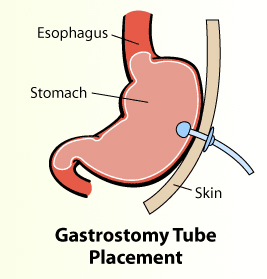In our experience with NBIA, the decision to place a G-tube is often difficult for families. To some, it may feel like they are losing ground in their fight against the disease by having to take this step. However, we have found that once it has been placed and people begin to see its benefits, they are often relieved and glad that they decided to have it done.
What is a G-tube?

A G-tube (short for gastrostomy tube) is a tube that is inserted into the abdomen and is used to deliver nutrition directly to the stomach
It is used to provide nutrition to individuals who have difficulty eating by mouth, cannot swallow safely, or need nutritional supplementation
What can be expected from the procedure?
- A gastrostomy surgery typically takes about 30 to 45 minutes
- After the surgery, individuals spend 1-2 days in the hospital and the stomach/abdomen heals completely in 5-7 days
- There may be some moderate pain caused by the procedure that can be treated with common pain medication
- Before leaving the hospital, a healthcare professional typically teaches the affected individual and/or their family the following things:
- How to care for the skin around the tube
- Signs and symptoms of infection
- What to do if the tube is pulled out
- Signs and symptoms of tube blockage
- How to empty the stomach through the tube
- How and what to feed through the tube
- How to hide the tube under clothing
- What normal activities can be continued
- A nutritionist can help plan out a specific diet and schedule based on the individual’s personal nutritional needs
- Follow-up visits should be scheduled to check the individual’s weight as well as the placement and condition of the tube
- A G-tube often lasts over a year before it needs to be replaced (replacement is done without surgery)
When should it be considered?
- When an individual cannot chew properly due to dystonia
- It may become too hard to eat or eating takes too long
- When an individual is choking or having difficulty with eating, drinking or swallowing
- When an individual has had, or is at risk of having, aspiration pneumonia
- When an individual is not gaining weight or keeping weight on and needs extra calories
- A G-tube should be considered when an individual is headed towards weight and nutrition loss
- It should be placed before too much weight is lost
- It may be better to do it early rather than having to consider it during a crisis time
What effect will it have on quality of life?
- G-tube feedings can be used to replace all oral feedings
- In some cases, the tube only supplements what an individual eats by mouth
- If an individual can’t chew well or just needs extra calories, they can still eat some things by mouth and use the G-tube to satisfy the rest of their nutritional needs
- If chewing is difficult, they can still eat things like ice cream or pudding by mouth
- Having a tube can make some individuals feel self-conscious
- They can consider replacing the tube with a button, which is more discrete
- A button is like a stopper that can be opened and closed for feedings as needed
Are there any side effects or cons?
- If not cared for properly, the gastrostomy site can become infected and/or irritated
- It must be kept clean and dry
- Hands must be washed before touching the tube or site of insertion
- Having a G-tube can sometimes decrease quality of life
- It causes a significant change in the individual and/or their family’s daily life
- Sometimes feedings by G-tube have to be done in public
- It can cause challenges during travel or vacations
Copyright © 2014 by NBIAcure.org. All rights reserved.